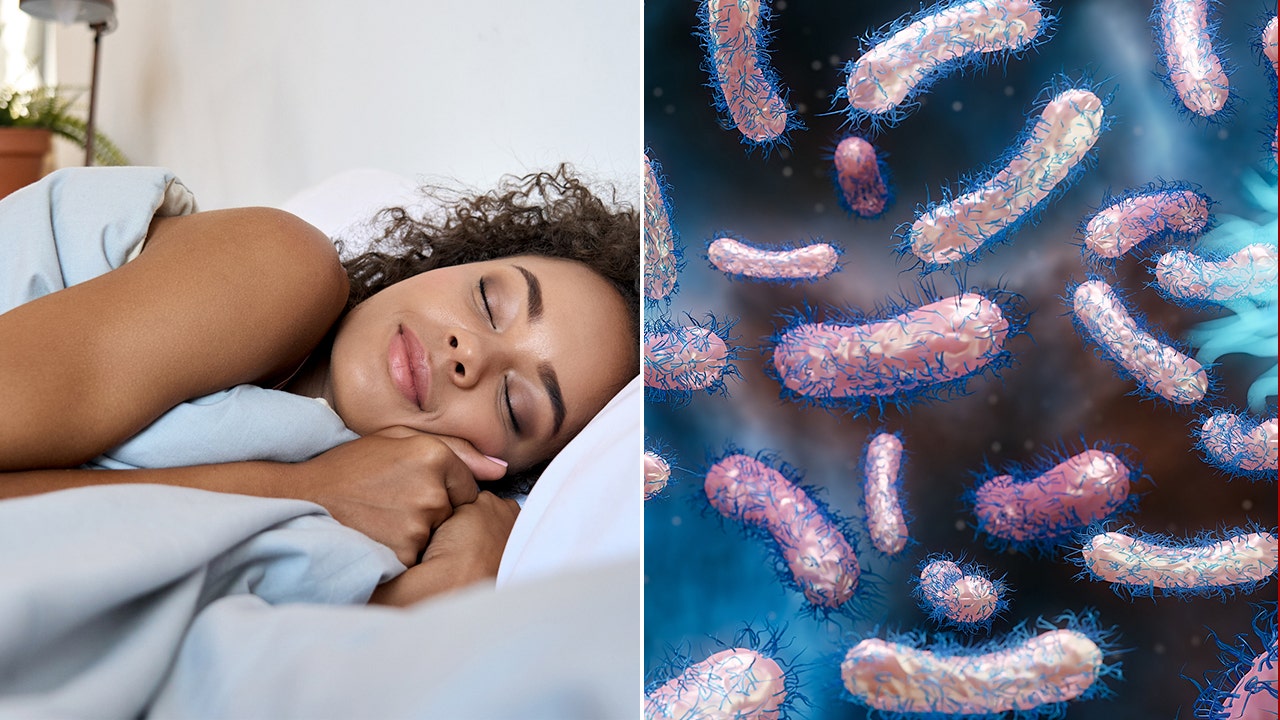Health
Dangers you can’t see may be lurking in your unwashed bedding, says study: Beware the ‘health concerns’

Monsters under the bed aren’t the only bedtime horrors to worry about.
Sheets and pillowcases may actually be embedded with bacteria, according to a new study by Amerisleep, a mattress company in Scottsdale, Arizona.
Unwashed bedding could even contain more bacteria than toilet seats after just one week, according to the study findings.
REUSABLE WATER BOTTLES CONTAIN MORE BACTERIA THAN TOILET SEATS DO, SAYS STUDY
During the study, volunteers swabbed their own sheets over a period of four weeks without washing them.
The company also took bacteria samples from mattresses that were anywhere from less than a year old to 7 years old.
Unwashed pillowcases and sheets contain many more bacteria than expected, according to an Amerisleep study. (iStock)
After just one week, the pillowcases sampled had at least three million colony-forming units (CFUs) per square inch – 17,442 times more bacteria than a toilet seat (172 CFUs).
After four weeks, the number of CFUs jumped to 11.96 million, which is 39 times more bacteria than a pet food bowl contains (306,000 CFUs).
SLEEP DEPRIVATION COULD REDUCE VACCINE ANTIBODIES, NEW STUDY FOUND
Sheets, on the other hand, collected about five million CFUs in one week, which is 24,631 times more bacteria than bathroom doorknobs (203 CFUs).
After four weeks, the bedsheet samples contained 11.32 million CFUs – more than five times more bacteria than a toothbrush holder.

After four weeks, the bedsheet samples contained 11.32 million CFUs – more than five times more bacteria than a toothbrush holder. (iStock)
The most common bacteria found in bedding was gram-negative rods, which made up more than 41% of what was identified on sheets and pillowcases.
Gram-negative rods can be dangerous and could lead to antibiotic resistance, according to CDC data.
POPULAR CONTACT LENSES COULD CONTAIN TOXIC ‘FOREVER CHEMICALS,’ NEW STUDY FINDS
The other two common bacteria found were gram-positive rods (24.94%) and bacilli (23.38%), which are usually the culprits behind food poisoning and similar infections, Amerisleep noted in its findings.
A mattress that’s less than a year old contains three million CFUs per square inch, the study found.

Seven-year-old mattresses revealed four different types of bacteria: gram-negative rods, gram-positive rods, gram-positive cocci and bacilli, according to Amerisleep. (iStock)
After seven years, the bacteria had grown to more than 16 million CFUs per square inch of mattress.
Mattresses that were less than a year old showed an equal number of gram-negative rods, gram-positive rods and gram-positive cocci for all bacteria identified.
INFECTIONS FROM POTENTIALLY DEADLY BACTERIA IN BABY FORMULA ADDED TO CDC WATCHLIST
The most common bacteria found on 7-year-old mattresses were gram-negative rods (37.36%). Mattresses of that age were the only ones to show all four types of bacteria.
In light of these findings, bedding should be washed once every seven days, said Amerisleep.
The maximum number of days sheets can go without being changed before being considered “gross” is 35 days, according to the company.

Bedding should be washed once every seven days, according to a new study. (iStock)
By 35 days, bedsheets will have accumulated more than 30 grams of dead skin cells, two gallons of body fluids like sweat and saliva, and more than one million dust mites.
Failure to wash sheets regularly can result in allergy symptoms like runny nose, coughing, sneezing, itchy skin and watery eyes.
WANT TO BE A MORNING PERSON? THESE 6 EXPERT TIPS MAY GET YOU THERE
“Washing sheets regularly is not only good hygiene, but it may also improve your sleep quality,” Amerisleep states on its website.
“More people feel excited about going to bed on fresh sheets,” the company added.
“Clean bedsheets invite sleep, which serves to boost your sleep quality.”
Fox News contributor Nicole Saphier, M.D., who studied microbiology as an undergraduate, emphasized the health concerns around sleeping on dirty sheets in a conversation with Fox News Digital.
“Conditions as benign as irritated skin, and rashes to more serious conditions, like acne, ringworm, and even pneumonia have all been associated with sleeping on dirty sheets,” she said.
“Our body comes into contact with many pathogens all throughout the day and of course, when we go to sleep, those pathogens transfer to our sheets.”
In addition to pathogens, Saphier explained that dirt, oil and other substances can “really build up and affect the immune system.”
“Washing sheets regularly is not only good hygiene, but it may also improve your sleep quality.”
Saphier suggested taking a shower prior to getting into bed, adding that drying wet hair before hitting the hay will prevent wetness on pillowcases from breeding pathogens, too.
“Also, be sure to wash your sheets at least once a week,” she said. “Anything longer than that is a bit gross and can lead to some health concerns.”
Washing your sheets weekly is recommended in most cases, per the guidance of WebMD.
Certain bedtime arrangements such as sleeping with pets can become a free-for-all for dust mites, which love to feed on dead skin cells, the site reported.

A woman sleeps with her dog. (iStock)
The average human sheds 500 million skin cells per day, according to WebMD, welcoming dust mites and their droppings into bed which can trigger allergies, asthma and other skin reactions.
If pets share the bed, they can spread such infections as mange or ringworm, which can cause skin reactions in humans, too.
Dirty pillowcases can also be the culprit for acne breakouts due to embedded dirt, dead skin and bacteria which can clog pores, WebMD reported.
CLICK HERE TO SIGN UP FOR OUR HEALTH NEWSLETTER
For bad breakouts, the health site suggested changing pillowcases every two to three days.
If you’re sick, bedding should be thrown into the wash immediately to kill lingering germs, WebMD said, since some bacteria and viruses can survive longer than others.

An illustration of dust mites on a pillow. (iStock)
Other factors that can add to gross stuff between the sheets include sleeping in the nude, snacking in bed, sleeping with kids or excessive sweating at night.
WebMD advised allowing your sheets to breathe in the morning, instead of making the bed right away, to allow covers a chance to dry and attract less bacteria.
The site also suggested washing bedding in hot water, if the care label allows, and using the dryer to kill any remaining germs that may have survived the wash cycle.
Color-safe bleach can also be used as an extra germ-killer on bedding, especially when cleaning up after an illness.

Health
Semaglutide Pills and Injections Vs. Drops: Experts Weigh In | Woman's World

Sign Up
Create a free account to access exclusive content, play games, solve puzzles, test your pop-culture knowledge and receive special offers.
Already have an account? Login
Use left and right arrow keys to navigate between menu items.
Use escape to exit the menu.
Health
Jennifer Hudson Lost 80-Lbs Without Depriving Herself—Learn Her Secrets

Sign Up
Create a free account to access exclusive content, play games, solve puzzles, test your pop-culture knowledge and receive special offers.
Already have an account? Login
Use left and right arrow keys to navigate between menu items.
Use escape to exit the menu.
Health
Kennedy’s Plan for the Drug Crisis: A Network of ‘Healing Farms’

Though Mr. Kennedy’s embrace of recovery farms may be novel, the concept stretches back almost a century. In 1935, the government opened the United States Narcotic Farm in Lexington, Ky., to research and treat addiction. Over the years, residents included Chet Baker and William S. Burroughs (who portrayed the institution in his novel, “Junkie: Confessions of an Unredeemed Drug Addict”). The program had high relapse rates and was tainted by drug experiments on human subjects. By 1975, as local treatment centers began to proliferate around the country, the program closed.
In America, therapeutic communities for addiction treatment became popular in the 1960s and ’70s. Some, like Synanon, became notorious for cultlike, abusive environments. There are now perhaps 3,000 worldwide, researchers estimate, including one that Mr. Kennedy has also praised — San Patrignano, an Italian program whose centerpiece is a highly regarded bakery, staffed by residents.
“If we do go down the road of large government-funded therapeutic communities, I’d want to see some oversight to ensure they live up to modern standards,” said Dr. Sabet, who is now president of the Foundation for Drug Policy Solutions. “We should get rid of the false dichotomy, too, between these approaches and medications, since we know they can work together for some people.”
Should Mr. Kennedy be confirmed, his authority to establish healing farms would be uncertain. Building federal treatment farms in “depressed rural areas,” as he said in his documentary, presumably on public land, would hit political and legal roadblocks. Fully legalizing and taxing cannabis to pay for the farms would require congressional action.
In the concluding moments of the documentary, Mr. Kennedy invoked Carl Jung, the Swiss psychiatrist whose views on spirituality influenced Alcoholics Anonymous. Dr. Jung, he said, felt that “people who believed in God got better faster and that their recovery was more durable and enduring than people who didn’t.”
-
/cdn.vox-cdn.com/uploads/chorus_asset/file/25822586/STK169_ZUCKERBERG_MAGA_STKS491_CVIRGINIA_A.jpg)
/cdn.vox-cdn.com/uploads/chorus_asset/file/25822586/STK169_ZUCKERBERG_MAGA_STKS491_CVIRGINIA_A.jpg) Technology1 week ago
Technology1 week agoMeta is highlighting a splintering global approach to online speech
-

 Science1 week ago
Science1 week agoMetro will offer free rides in L.A. through Sunday due to fires
-
/cdn.vox-cdn.com/uploads/chorus_asset/file/23935558/acastro_STK103__01.jpg)
/cdn.vox-cdn.com/uploads/chorus_asset/file/23935558/acastro_STK103__01.jpg) Technology1 week ago
Technology1 week agoAmazon Prime will shut down its clothing try-on program
-

 News1 week ago
News1 week agoMapping the Damage From the Palisades Fire
-
/cdn.vox-cdn.com/uploads/chorus_asset/file/25826211/lorealcellbioprint.jpg)
/cdn.vox-cdn.com/uploads/chorus_asset/file/25826211/lorealcellbioprint.jpg) Technology7 days ago
Technology7 days agoL’Oréal’s new skincare gadget told me I should try retinol
-
/cdn.vox-cdn.com/uploads/chorus_asset/file/25832751/2192581677.jpg)
/cdn.vox-cdn.com/uploads/chorus_asset/file/25832751/2192581677.jpg) Technology4 days ago
Technology4 days agoSuper Bowl LIX will stream for free on Tubi
-

 Business5 days ago
Business5 days agoWhy TikTok Users Are Downloading ‘Red Note,’ the Chinese App
-
/cdn.vox-cdn.com/uploads/chorus_asset/file/25835602/Switch_DonkeyKongCountryReturnsHD_scrn_19.png)
/cdn.vox-cdn.com/uploads/chorus_asset/file/25835602/Switch_DonkeyKongCountryReturnsHD_scrn_19.png) Technology2 days ago
Technology2 days agoNintendo omits original Donkey Kong Country Returns team from the remaster’s credits

















